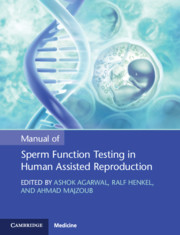Book contents
- Manual of Sperm Function Testing in Human Assisted Reproduction
- Cambridge Laboratory Manuals in Assisted Reproductive Technology
- Manual of Sperm Function Testing in Human Assisted Reproduction
- Copyright page
- Dedication
- Contents
- Contributors
- Short Biography
- Foreword
- Preface
- Introduction
- Chapter 1 Standard Semen Examination: Manual Semen Analysis
- Chapter 2 Standard Semen Analysis: Computer-Assisted Semen Analysis
- Chapter 3 Standard Semen Analysis: Home Sperm Testing
- Chapter 4 Standard Semen Analysis: Leukocytospermia
- Chapter 5 Standard Semen Analysis: Morphology
- Chapter 6 Sperm Vitality: Eosin-Nigrosin Dye Exclusion
- Chapter 7 Sperm Vitality: Hypo-Osmotic Swelling Test
- Chapter 8 Determination of Mitochondrial Membrane Potential by Flow Cytometry in Human Sperm Cells
- Chapter 9 Capacitation and Acrosome Reaction: Fluorescence Techniques to Determine Acrosome Reaction
- Chapter 10 Capacitation and Acrosome Reaction: Histochemical Techniques to Determine Acrosome Reaction
- Chapter 11 Zona Binding: Competitive Sperm-Binding Assay
- Chapter 12 Zona Binding: Hemizona Assay
- Chapter 13 Oolemma Binding: Sperm Penetration Assay
- Chapter 14 Oxidative Stress Testing: Direct Tests
- Chapter 15 Oxidative Stress Testing: Indirect Tests
- Chapter 16 Chromatin Condensation: Aniline Blue Stain
- Chapter 17 Chromatin Condensation: Chromomycin A3 (CMA3) Stain
- Chapter 18 Sperm Chromatin Structure: Toluidine Blue Staining
- Chapter 19 DNA Damage: TdT-Mediated dUTP Nick-End-Labelling Assay
- Chapter 20 DNA Damage: Sperm Chromatin Structure Assay
- Chapter 21 DNA Damage: COMET Assay
- Chapter 22 DNA Damage: Halo Sperm Test
- Chapter 23 DNA Damage: Fluorescent In-Situ Hybridization
- Chapter 24 Clinical Value of Sperm Function Tests
- Chapter 25 Future Developments: Sperm Proteomics
- Conclusion
- Index
- References
Chapter 2 - Standard Semen Analysis: Computer-Assisted Semen Analysis
Published online by Cambridge University Press: 05 April 2021
- Manual of Sperm Function Testing in Human Assisted Reproduction
- Cambridge Laboratory Manuals in Assisted Reproductive Technology
- Manual of Sperm Function Testing in Human Assisted Reproduction
- Copyright page
- Dedication
- Contents
- Contributors
- Short Biography
- Foreword
- Preface
- Introduction
- Chapter 1 Standard Semen Examination: Manual Semen Analysis
- Chapter 2 Standard Semen Analysis: Computer-Assisted Semen Analysis
- Chapter 3 Standard Semen Analysis: Home Sperm Testing
- Chapter 4 Standard Semen Analysis: Leukocytospermia
- Chapter 5 Standard Semen Analysis: Morphology
- Chapter 6 Sperm Vitality: Eosin-Nigrosin Dye Exclusion
- Chapter 7 Sperm Vitality: Hypo-Osmotic Swelling Test
- Chapter 8 Determination of Mitochondrial Membrane Potential by Flow Cytometry in Human Sperm Cells
- Chapter 9 Capacitation and Acrosome Reaction: Fluorescence Techniques to Determine Acrosome Reaction
- Chapter 10 Capacitation and Acrosome Reaction: Histochemical Techniques to Determine Acrosome Reaction
- Chapter 11 Zona Binding: Competitive Sperm-Binding Assay
- Chapter 12 Zona Binding: Hemizona Assay
- Chapter 13 Oolemma Binding: Sperm Penetration Assay
- Chapter 14 Oxidative Stress Testing: Direct Tests
- Chapter 15 Oxidative Stress Testing: Indirect Tests
- Chapter 16 Chromatin Condensation: Aniline Blue Stain
- Chapter 17 Chromatin Condensation: Chromomycin A3 (CMA3) Stain
- Chapter 18 Sperm Chromatin Structure: Toluidine Blue Staining
- Chapter 19 DNA Damage: TdT-Mediated dUTP Nick-End-Labelling Assay
- Chapter 20 DNA Damage: Sperm Chromatin Structure Assay
- Chapter 21 DNA Damage: COMET Assay
- Chapter 22 DNA Damage: Halo Sperm Test
- Chapter 23 DNA Damage: Fluorescent In-Situ Hybridization
- Chapter 24 Clinical Value of Sperm Function Tests
- Chapter 25 Future Developments: Sperm Proteomics
- Conclusion
- Index
- References
Summary
Computer-assisted semen analysis (CASA) is an automated and objective method to evaluate several sperm parameters, either in conjunction with or instead of routine manual semen analysis. CASA systems have undergone a complete metamorphosis since the initial systems were developed to track sperm motion four decades ago [see 1, 2 for detailed history]. Various innovations in bioengineering, software algorithms and computational power have led to more than 14 CASA systems (Figure 2.1) currently available across the globe for commercial use in evaluating both human and animal spermatozoa [3, 4, 5]. Although CASA was initially introduced as a research tool and not commonly used for semen analysis in the clinical setting [1], more and more fertility clinics are investing in and switching to automated systems.
- Type
- Chapter
- Information
- Publisher: Cambridge University PressPrint publication year: 2021

